By Gabe Rijpma, Senior Director Health & Social Services, Microsoft Asia
 By 2020, a million new devices will be online every single hour[1]. These devices comprise not just consumer devices like mobile phones and tablets but also devices such as sensors and intelligent buildings that are connected online. Additionally, in under ten years, 60 percent of computing will be in the public cloud.
By 2020, a million new devices will be online every single hour[1]. These devices comprise not just consumer devices like mobile phones and tablets but also devices such as sensors and intelligent buildings that are connected online. Additionally, in under ten years, 60 percent of computing will be in the public cloud.
All industries around the world are assessing how they can gain advantage from new technologies like Internet of Things (IoT) and machine learning, and this is especially so in the healthcare industry. Goldman Sachs[2] estimates that digital health can save the US some US$305 billion a year and the digital healthcare industry can generate as much as US$32.4 billion a year in revenue.
Varying Degrees of Health in Asia
The health industry in Asia is a unique industry with its own set of challenges that vary across developed and emerging markets. Challenges like growing populations, chronic disease burden, longer life spans, strained budgets, compliance, technology silos, medical advances and cyber threats burden the industry where needs are infinite while resources are mostly finite.
Emerging markets in Asia like Indonesia, Philippines and Vietnam are challenged with large populations of undiagnosed and untreated patients. In these markets, there is an urgent need to expand the health system’s capabilities to deliver quality healthcare.
In India, with limited resources and close to 850 million people living in remote, rural areas, much of the population lacks access to quality healthcare. On the other end of the spectrum, in developed markets like New Zealand and Singapore, ageing populations mean health organizations need to empower aged patients and assist them and their loved ones to be more informed about their health. In fact, by 2050, Asia’s elderly population will have tripled, reaching close to 1.3 billion. This means that 1 out of every 4 people will be over 60 years old.
Organizations and governments alike are serious about digital transformation within healthcare delivery models. For example, as part of the Thai government’s overall vision for “Digital Thailand,” an eHealth strategy was developed to improve the quality and coordination of healthcare services in Thailand. Additionally, a study by The Associated Chambers of Commerce & Industry of India (ASSOCHAM) revealed that India’s virtual health market has the potential to cross the $32 million mark by 2020 from today’s level of over $15 million. In New Zealand, the Ministry of Health has officially accepted Microsoft’s Trusted Public Cloud services for advancing the country’s electronic health service capabilities.
The Health Industry Aspiration: From Sick Care to Wellness
My conversations with health organizations and government representatives in Asia have given me some insight into what we call ‘the health industry aspiration’. The industry aspires to transform the present ‘sick care’ system from simply attending to patients when in need to improving care outcomes, promoting population wellness and harnessing data. This will place the most important person – the patient – in the center of the care continuum.
In fact, in a recent Microsoft Asia Digital Transformation Study[3] which involved 247 business leaders in the health industry, engaging patients was the number two digital transformation priority among respondents. However, only 25% of business leaders polled have a full digital transformation strategy in place, which means organizations need to accelerate their transformation process to meet the healthcare demands of tomorrow.
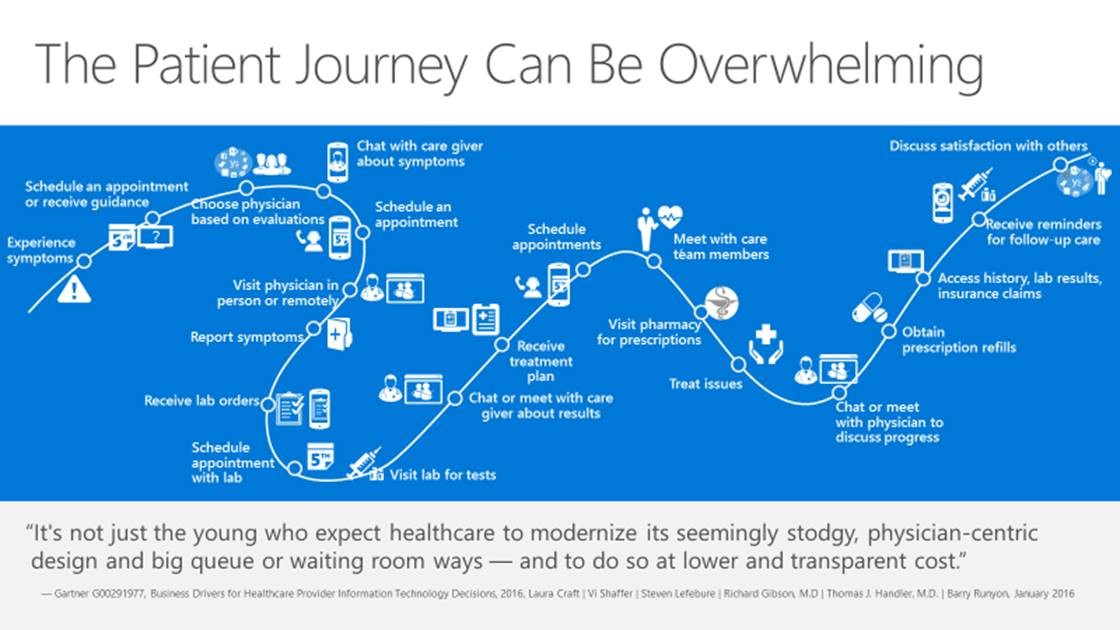
Unfortunately, the present patient journey is often complicated and overwhelming. There are many steps from the time the patient discovers he is ill to receiving care and follow up care to the stage he is satisfied with the service. Throughout this journey which can often be an emotional one for the patient and family members, he or she interacts with different care providers and moves to different locations. There is often no single point to tie the journey for improved access, and efficient and continued engagement throughout the care continuum.
Realizing the Future of the Patient Journey in Asia
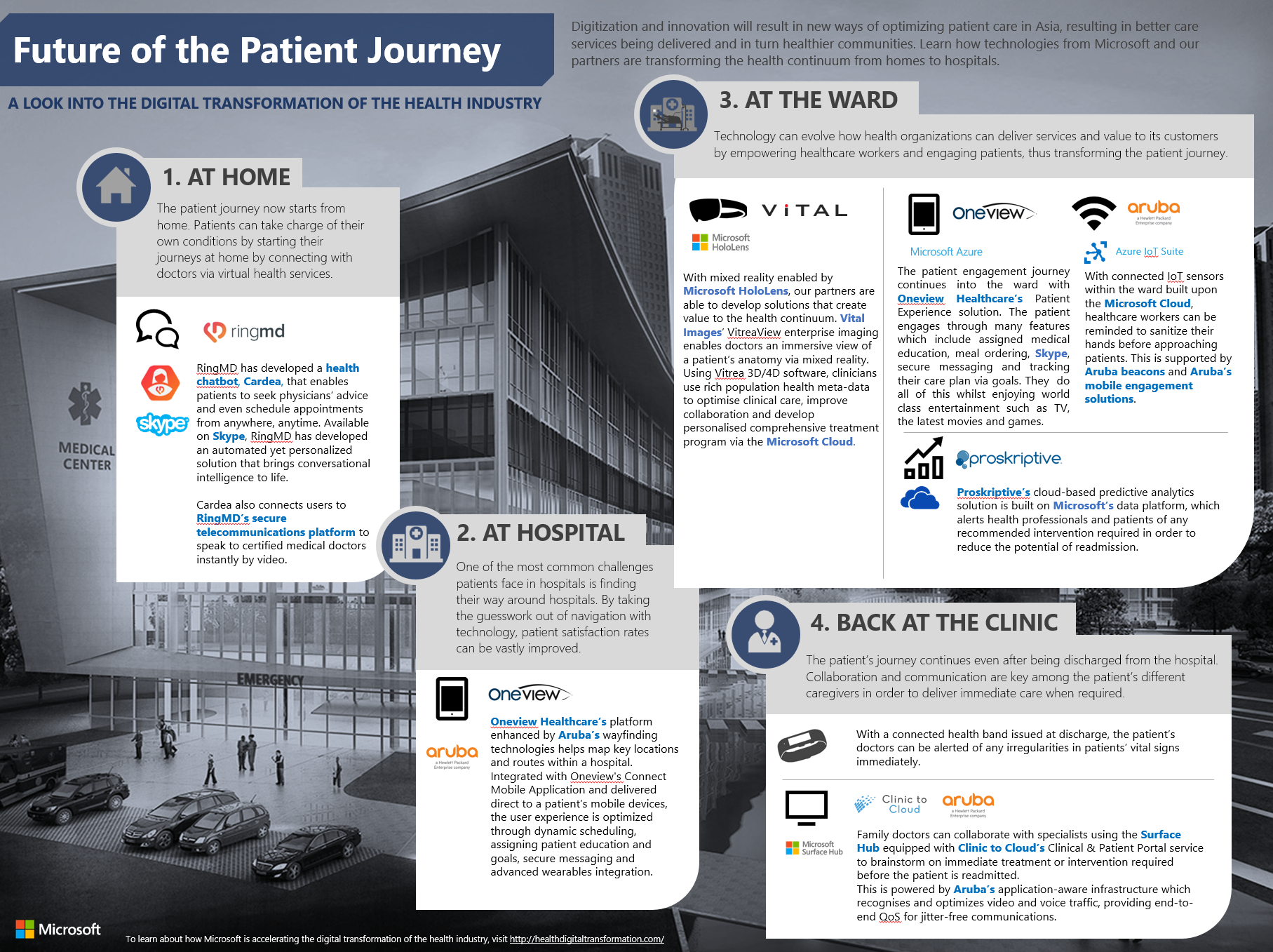
We are excited to have our partners working with governments and hospitals in Asia to simplify the patient journey by putting the patient in the center of care through digitization and innovation at different stages of interaction: At home, at the hospital, at the ward and lastly back at the clinic.
Enhanced and increased access for patients across Asia, even from the comfort of their homes
Healthcare organizations and partners in Asia are paving way for doctors, staff and patients to virtually connect, automate ways to provide information about patient health and find the right doctor to schedule appointments.
In Vietnam, CLAS Healthcare currently serves more than one million Vietnamese and has over 500 doctors registered within its system. The CLAS platform allows patients to online schedule and re-schedule appointments helping to reduce patient wait time, and improves care delivery by integrating patient history within its apps for doctors to monitor virtually and remotely. With Microsoft Azure and SQL, CLAS can now store large amounts of patient information securely, and registered doctors use Power BI to analyze their clinical and operational effectiveness to serve patients better.
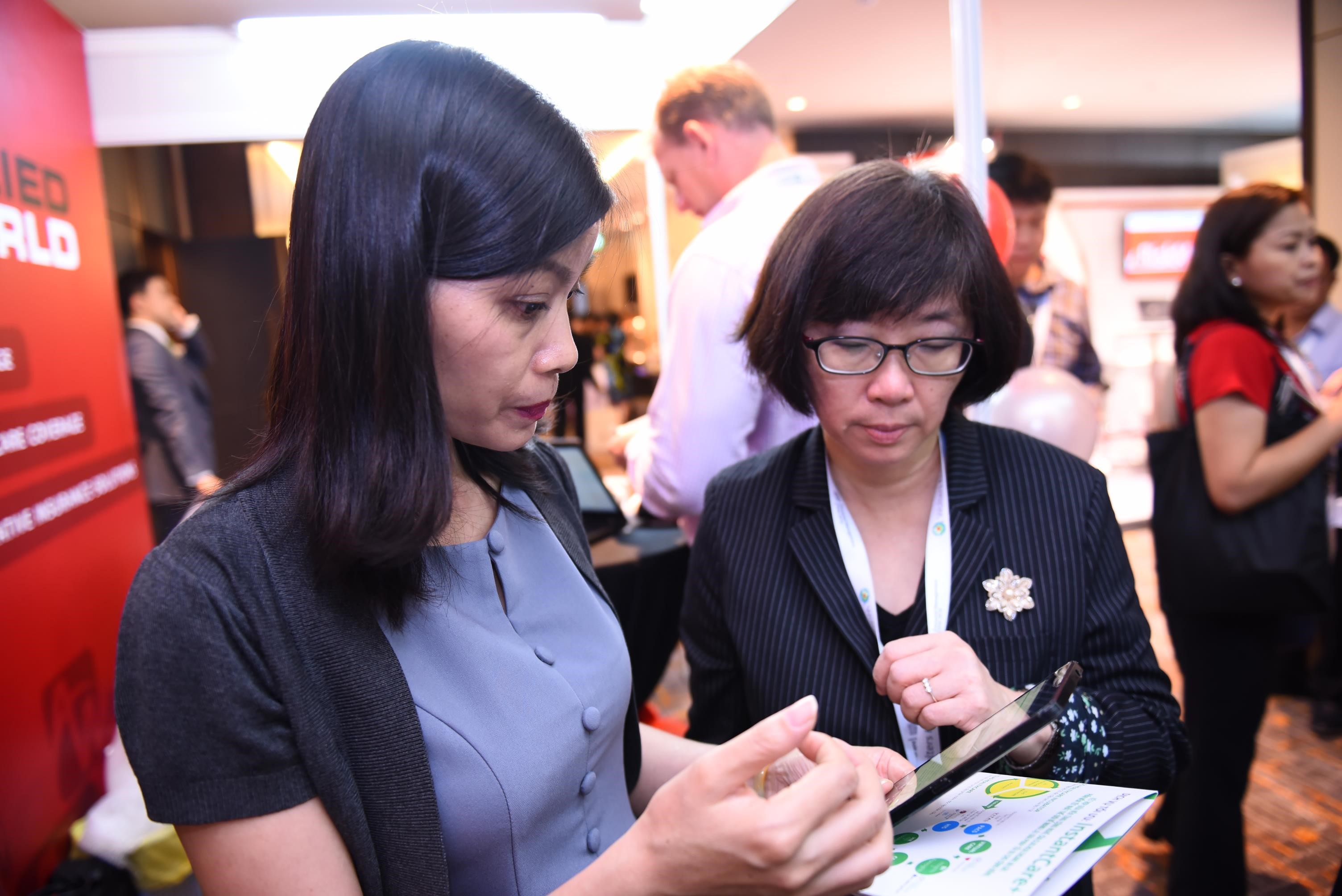
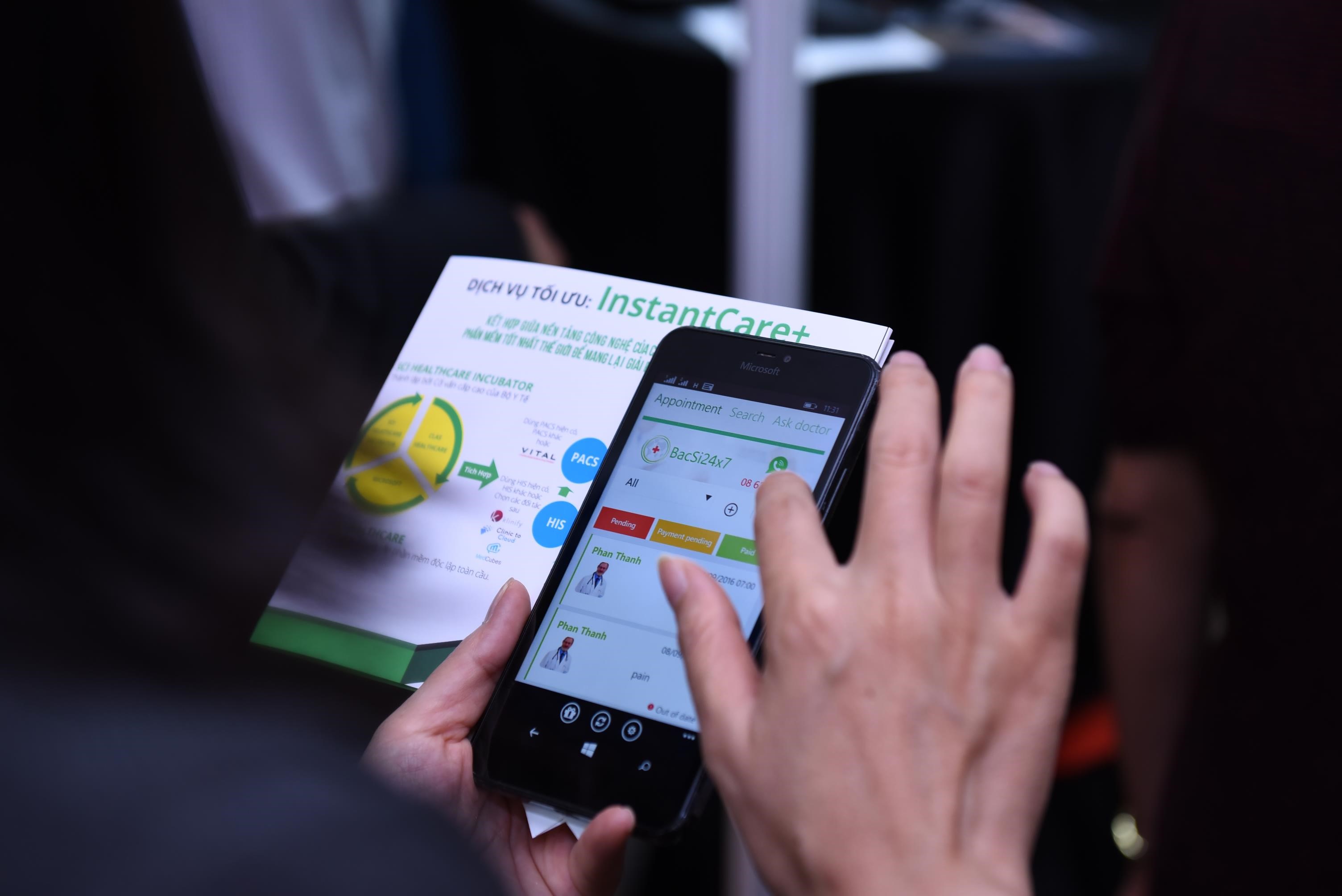
More engagement with patients across the patient journey
An empowered and engaged patient is likely to respond better to treatment. Oneview Healthcare helps healthcare providers engage patients throughout the continuum of care with its Patient Experience solution. Patients get to understand their care program better to achieve desired results. The solution assigns medical education, options to order meals or seek help from nurses, and enables patients and care teams to track progress online.
In fact, a study done at Epworth HealthCare, the largest not-for-profit private health care group in Australia’s state of Victoria, found that patients and families that used the Patient Experience solution to prepare for discharge with video education, goal completion and real-time collaboration with their care teams, experienced a six percent reduction in average length of stay at the hospital.
Oneview Healthcare and Microsoft have partnered from the start, since Oneview’s inception more than nine years ago. Every Oneview end user device runs on Windows, while its backend is built on SQL platform, ensuring seamless and secure integration of patient data.
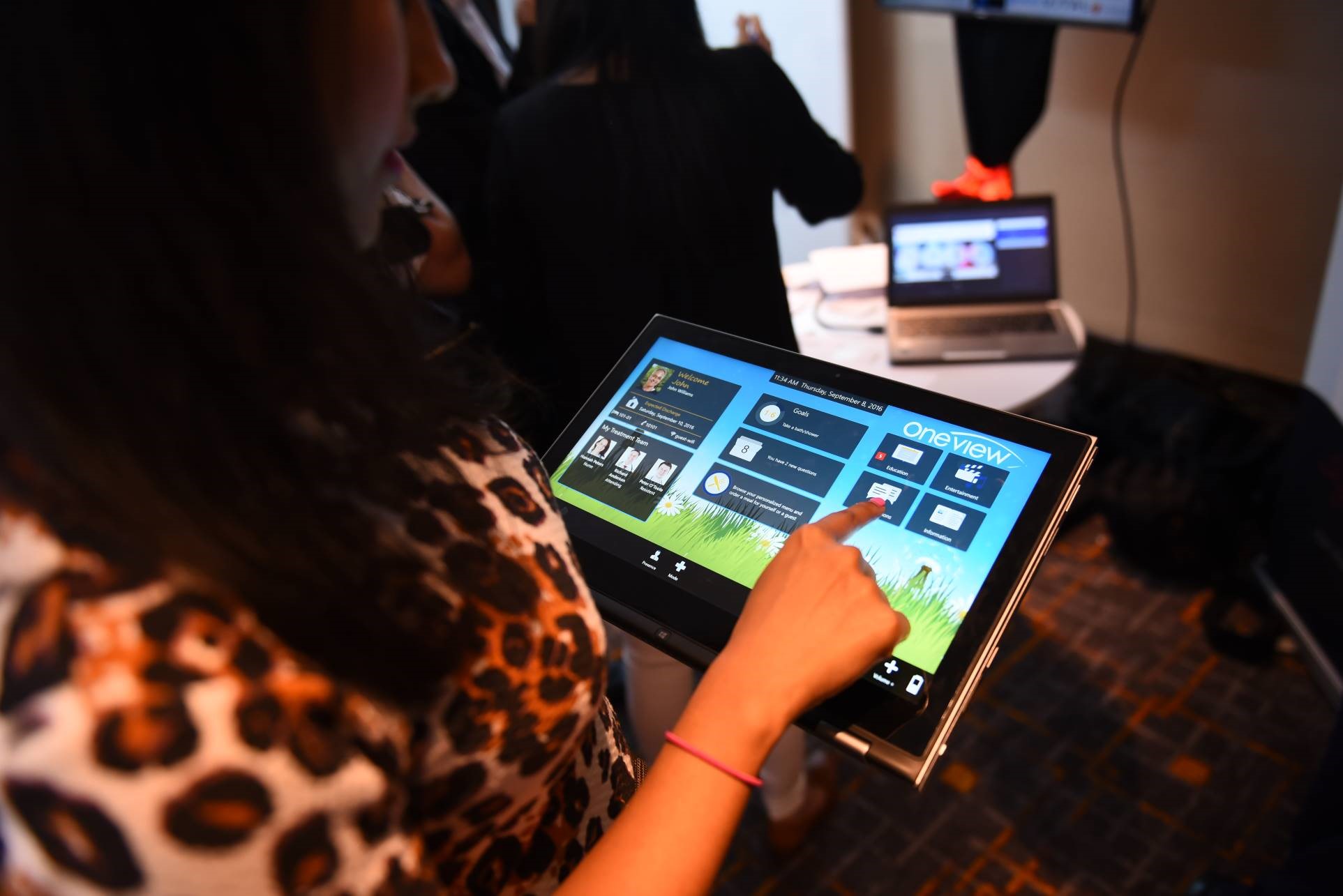
At Ryman Healthcare in New Zealand, CEO Simon Challies had a vision to dramatically impact the lives of Ryman’s retirement and rest home residents. That vision led to myRyman, a Windows 10 app, that is helping revolutionize the way people in its communities live and are cared for. The app allows staff to communicate with one another and check which residents they are expected to see on the day. When it is complete, myRyman will also provide transparency to residents, giving them an opportunity to understand how Ryman Healthcare staff are working around the clock to provide the best patient care.
More empowerment of healthcare staff to attend to patients effectively
With digitization, health staff are empowered to continue communication between visits, both inside and outside the care setting. Follow up care even after the patient has left the hospital can be facilitated through take home devices like the Microsoft Band, enriching healthcare staff with more information about the patient.
The partnership between Vital Images, an advanced medical imaging and informatics company, and Clinic to Cloud, a global patient centric and virtual care enabled practice management software, empowered by Microsoft Azure, is an example of empowering care teams to better collaborate to provide quicker and better service. Vital Images have integrated their imaging solutions with Clinic to Cloud’s solution, enabling care staff to access patient images of anatomy and physiological functions in 2D, 3D and 4D – together with their holistic patient history. Clinicians and specialists can access this repository of patient information to monitor their progress as well as virtually communicate with family doctors on patient care outside of the hospital. This continuous engagement ensures there is no break in the patient journey especially after he or she has left the hospital, reducing the need for readmission.
Additionally, Vital Images deal with large amounts of data that go into Petabytes. To Dr Ravi Shrestha, General Manager of Asia Pacific at Vital Images, the correct choice of a trusted cloud partner was critical to hosting such large amounts of patient data: “In the last 30 years since our inception, we have delivered imaging informatics solutions to more than 5,000 installations around the world. We transmit an enormous amount of data and Microsoft Azure was a clear choice when it came to choosing who would host the data in a secure manner, without disruption.”
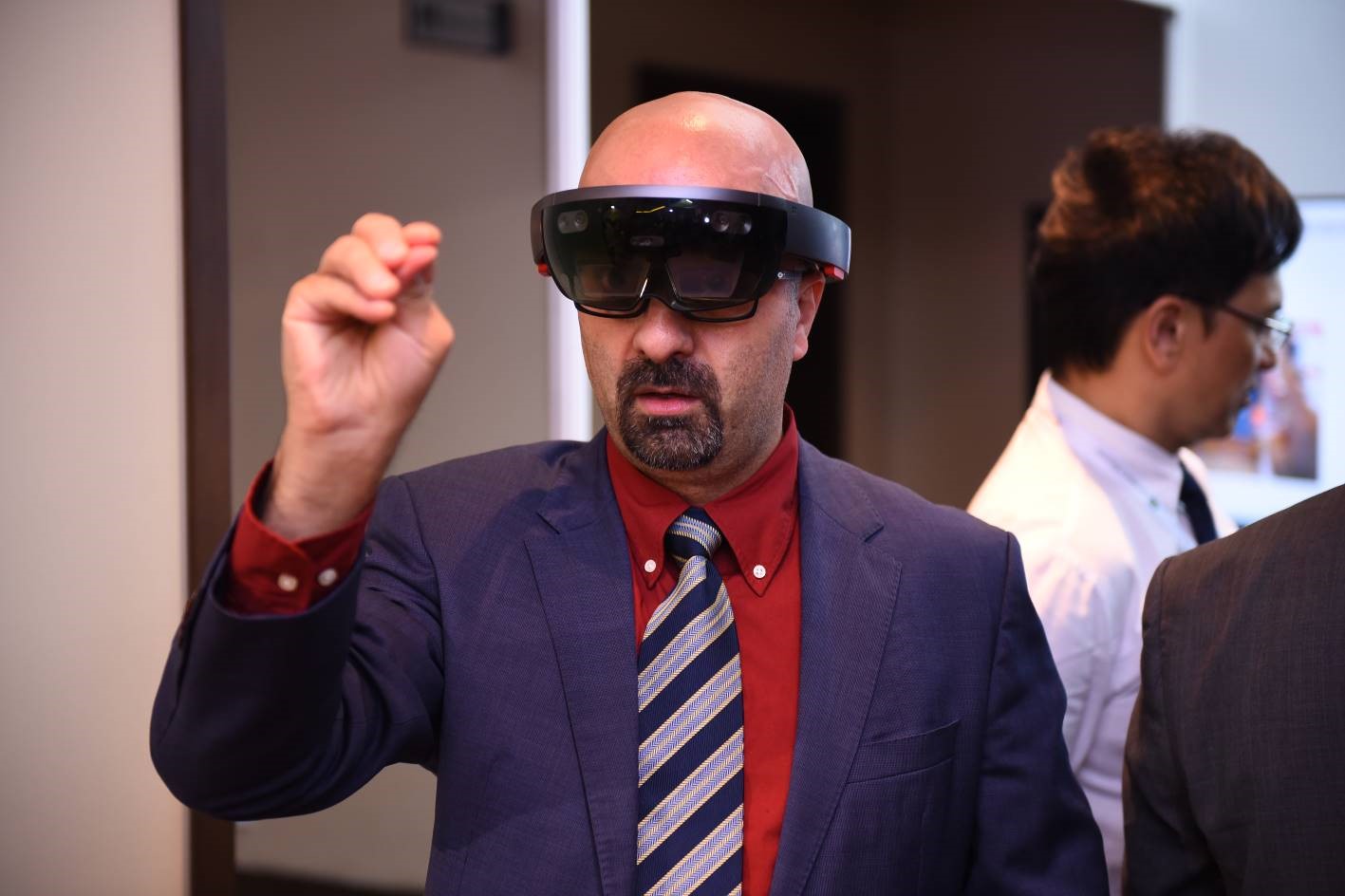
Vital Images are also exploring the potential application of the Microsoft HoloLens as an extension of its enterprise visualization solution providing clinicians an immersive view of a patient’s anatomy, while extending that visibility to remote team members, consulting physicians or healthcare informatics partners.
An example of a hospital empowering its staff through technology is Max Healthcare in India. Max has improved its community outreach and engagement for early detection and diagnosis through Microsoft CRM Online. By using a common platform that integrates all of patients’ data and details, doctors are provided with enough information about the patient history from first contact with Max to post-operative care.
Microsoft Health Innovation Labs – Bringing virtual health to reality
In response to the demand to simplify the patient journey, we are accelerating start-ups focused around digital health, through our Microsoft Health Innovation Labs across Asia.
Our labs help bring together local and global, best-of-breed, non-competing ISVs with open architecture – amongst others, CLAS Healthcare, Clinic To Cloud, MedCubes, Proskriptive, ConnectedLife and Vital Images – to deliver innovative future-proof virtual health solutions as required uniquely for Asia. This ecosystem includes players ranging from medical technology to pharmaceutical to telecommunications and even investors.
At the labs, we equip our partners with advanced technologies from Microsoft, including innovations involving our work with Conversations as a Platform and IoT, and individuals who are highly specialized in these technologies to allow significant speed of innovation and eventually bring them to those who need them the most – the patient. Since the beginning of the year, we have launched Microsoft Health Innovation Labs in Vietnam and Malaysia, and look forward to launching more labs across Asia.
The complex nature of the Asia region means that there is no one-size-fits-all solution. Governments and hospitals are evaluating solutions to ascertain the ones that best suit their culture, needs and requirements of patients and families. What remains constant across Asia is however the need to increase access, simplify the patient journey and engage with patients better throughout the care continuum while optimizing resources through digitization.
[1] Gartner, Gartner Predicts Our Digital Future: http://www.gartner.com/smarterwithgartner/gartner-predicts-our-digital-future/
[2] Business Insider, Goldman Sachs says a digital healthcare revolution is coming – and it could save America $300 billion: http://www.businessinsider.sg/goldman-digital-healthcare-is-coming-2015-6/?r=US&IR=T#EEaaZRCaZPPfZ8AF.97
[3] The Microsoft Asia Digital Transformation Study was conducted between October to November 2016 involving 1,494 business leaders in 13 Asia Pacific markets. The 13 markets include Australia, China, Hong Kong, Indonesia, India, Japan, Korea, Malaysia, New Zealand, the Philippines, Singapore, Taiwan and Thailand. All respondents were pre-qualified as being involved in shaping their organizations’ digital strategy, and are working in firms with more than 250 employees.






